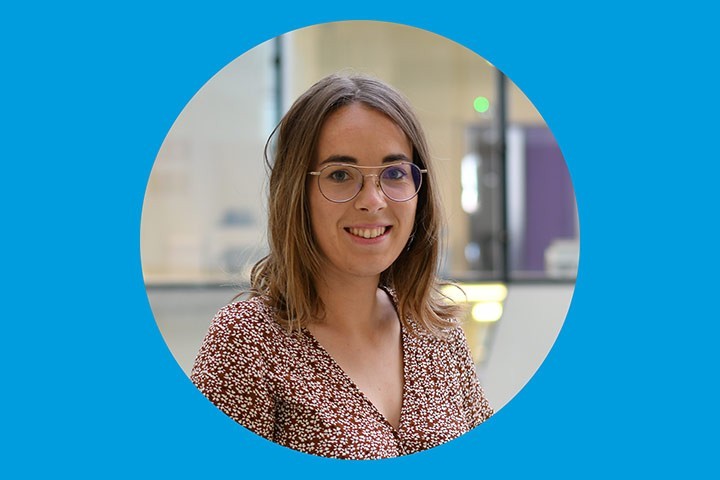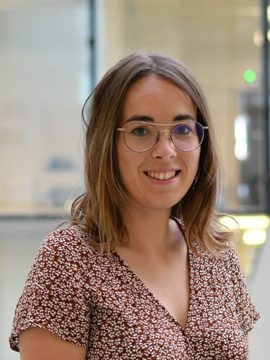
Interview: Sophie Gauthier
The neuroscience community in Bordeaux is rich with about 150 students in M1 and M2, about 40 new PhD students each year, and a very dynamic association, the NBA (Neuroscience Bordeaux Association). Meeting with Sophie Gauthier, who has chaired the association for the past two years and who will soon be passing on the baton.
Bordeaux Neurocampus : Students in neuroscience have varied backgrounds. What is yours?

Sophie Gauthier : After my bachelor’s degree, I started by studying medicine: I wanted to understand how the human body works in general. But after two years I branched off to a degree in biology, and this allowed me to go to cellular and molecular scales. I had the opportunity to do an internship in neuroscience research in Marseille and as this really interested me, I joined the Master of Neuroscience in Bordeaux. I am currently in the second year of my thesis in the team where I did my master’s internship. I changed the subject but I stayed in this team because I was interested in the topic.
Your team, Physiology and Physiopathology of Executive Functions, led by Thomas Boraud and Pierre Burbaud, covers many topics of study. What are the main axes at the moment?
Our approach is relatively translational: we are working on clinical aspects, but also fundamental aspects, with animal models such as rodents, birds, or salamanders. The aim is to answer a question: the mechanisms underlying the executive functions, i.e. planning of movement, decision making: Arthur Leblois is working on learning with birds, Marc Deffains on decision making with primates…
This implies understanding the functioning of the different structures involved in these functions, at the level of neurons, and the connections between them. The objective of my thesis is to study in a physiological framework the role of dopamine, which is known to be important in Parkinson’s disease, in the control of movement.
You are also the president of the NBA (Neuroscience in Bordeaux Association). What are the main missions of the association?
The goal of the association is to support students in neuroscience in Bordeaux. We act as an intermediary between the educational teams and the master and thesis students. We also aim to establish cohesion between members. Incoming Master 1 students often don’t know anyone, so we try to create links between the graduating classes. To do this we make sponsorships, and we organize different events. This allows us to create a network of students which is very important and which we try to nurture as much as possible, especially to choose their internship, thesis or post-doctorate. My missions as president are to create cohesion within the board of directors who give ideas, and to make the link with the pedagogical teams of the Bordeaux Neurocampus and the university.
Our other missions consist in sharing science, for PhD students and more broadly researchers from the community, with the PhD seminars, the first Friday of each month, organized with the PhD students themselves and in collaboration with the department. For the general public, we are also involved in Neurodon, which this year has been postponed to November, and in the “Twenty Km of Saint-Émilion”.
What did you focus on during your mandate?
The objective was to improve our communication. We started to feed it notably by setting up an Instagram account, and we really increased the number of publications on the Facebook page to encourage communication of all scientific events, in Bordeaux and internationally. The association was created for master’s and thesis students, but generally it’s mostly master’s students who benefit from it, so we tried to better integrate doctoral students. For this purpose, we organized two inter-association evenings, with only thesis students from all the doctoral schools in Bordeaux, as well as a meeting with former doctoral students, on the issue of post-docs, in collaboration with the 2D2B association (for students in Biology). We had some additional projects on the end of the academic year, but they will be postponed!
How many members does the NBA have, and what contact do you have with alumni?
We have 390 members. When you join the association, you become a member for life. We have little contact with the alumni, it’s something we should work on with the next offices, because I think it would be interesting to use this network even more. The only contact we have is when we solicit them for events on the possibilities that are available to a student after his thesis or master’s degree in neuroscience.
Will there soon be changes in the board?
Yes, because I started my term in 2018, and it is a two-year term ending in October. The board will be redesigned, hoping that new master’s or thesis students will be motivated to take over the reins. Every year, on the board of directors, some leave, others come back, and the M1s who arrive can join and participate in the organization of various events, even if the board is already formed. Motivated students are therefore welcome!
Interview: Nathan Florent
More details
Team Physiologie et physiopathologie des fonctions exécutives
Last update 09/09/20
